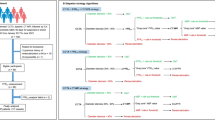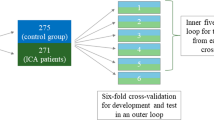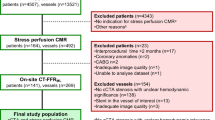Abstract
Purpose
To evaluate the diagnostic accuracy of a deep learning (DL) algorithm predicting hemodynamically significant coronary artery disease (CAD) by using a rest dataset of myocardial computed tomography perfusion (CTP) as compared to invasive evaluation.
Methods
One hundred and twelve consecutive symptomatic patients scheduled for clinically indicated invasive coronary angiography (ICA) underwent CCTA plus static stress CTP and ICA with invasive fractional flow reserve (FFR) for stenoses ranging between 30 and 80%. Subsequently, a DL algorithm for the prediction of significant CAD by using the rest dataset (CTP-DLrest) and stress dataset (CTP-DLstress) was developed. The diagnostic accuracy for identification of significant CAD using CCTA, CCTA + CTP stress, CCTA + CTP-DLrest, and CCTA + CTP-DLstress was measured and compared. The time of analysis for CTP stress, CTP-DLrest, and CTP-DLStress was recorded.
Results
Patient-specific sensitivity, specificity, NPV, PPV, accuracy, and area under the curve (AUC) of CCTA alone and CCTA + CTPStress were 100%, 33%, 100%, 54%, 63%, 67% and 86%, 89%, 89%, 86%, 88%, 87%, respectively. Patient-specific sensitivity, specificity, NPV, PPV, accuracy, and AUC of CCTA + DLrest and CCTA + DLstress were 100%, 72%, 100%, 74%, 84%, 96% and 93%, 83%, 94%, 81%, 88%, 98%, respectively. All CCTA + CTP stress, CCTA + CTP-DLRest, and CCTA + CTP-DLStress significantly improved detection of hemodynamically significant CAD compared to CCTA alone (p < 0.01).
Time of CTP-DL was significantly lower as compared to human analysis (39.2 ± 3.2 vs. 379.6 ± 68.0 s, p < 0.001).
Conclusion
Evaluation of myocardial ischemia using a DL approach on rest CTP datasets is feasible and accurate. This approach may be a useful gatekeeper prior to CTP stress..





Similar content being viewed by others
References
Ford ES, Capewell S. Coronary heart disease mortality among young adults in the U.S. from 1980 through 2002: concealed leveling of mortality rates. J Am CollCardiol. 2007;50:2128–2132.
Pontone G, Andreini D, Bartorelli AL, Bertella E, Cortinovis S, Mushtaq S, et al. A long-term prognostic value of CT angiography and exercise ECG in patients with suspected CAD. JACC Cardiovasc Imaging. 2013;6:641–50.
Knuuti J, Wijns W, Saraste A, Capodanno D, Barbato E, Funck-Brentano C, et al. 2019 ESC Guidelines for the diagnosis and management of chronic coronary syndromes. Eur Heart J. 2020;41:407–77.
Pontone G, Muscogiuri G, Andreini D, Guaricci AI, Guglielmo M, Mushtaq S, et al. The new frontier of cardiac computed tomography angiography: fractional flow reserve and stress myocardial perfusion. Curr Treat Options Cardiovasc Med. 2016;18:74.
Pontone G, Andreini D, Guaricci AI, Baggiano A, Fazzari F, Guglielmo M, et al. Incremental diagnostic value of stress computed tomography myocardial perfusion with whole-heart coverage CT scanner in intermediate- to high-risk symptomatic patients suspected of coronary artery disease. JACC Cardiovasc Imaging. 2019;12:338–49.
Pontone G, Guaricci AI, Palmer SC, Andreini D, Verdecchia M, Fusini L, et al. Diagnostic performance of non-invasive imaging for stable coronary artery disease: a meta-analysis. Int J Cardiol. 2020;300:276–81.
Baggiano A, Fusini L, Del Torto A, Vivona P, Guglielmo M, Muscogiuri G, et al. Sequential strategy including FFRCT Plus Stress-CTP impacts on management of patients with stable chest pain: the stress-CTP RIPCORD study. J Clin Med. 2020;9(7):2147.
Pontone G, Weir-McCall JR, Baggiano A, Del Torto A, Fusini L, Guglielmo M, et al. Determinants of rejection rate for coronary CT angiography fractional flow reserve analysis. Radiology. 2019;292:597–605.
Carrascosa P, Capunay C. Myocardial CT perfusion imaging for ischemia detection. Cardiovasc Diagn Ther. 2017;7:112–28.
Lee JM, Choi G, Koo BK, Hwang D, Park J, Zhang J, et al. Identification of high-risk plaques destined to cause acute coronary syndrome using coronary computed tomographic angiography and computational fluid dynamics. JACC Cardiovasc Imaging. 2019;12:1032–43.
Kim SM, Cho YK, Choe YH. Adenosine-stress dynamic myocardial perfusion imaging using 128-slice dual-source CT in patients with normal body mass indices: effect of tube voltage, tube current, and iodine concentration on image quality and radiation dose. Int J Cardiovasc Imaging. 2014;30(Suppl 2):95–103.
Muscogiuri G, Chiesa M, Trotta M, Gatti M, Palmisano V, Dell’Aversana S, et al. Performance of a deep learning algorithm for the evaluation of CAD-RADS classification with CCTA. Atherosclerosis. 2020;294:25–32.
Al’Aref SJ, Anchouche K, Singh G, Slomka PJ, Kolli KK, Kumar A, et al. Clinical applications of machine learning in cardiovascular disease and its relevance to cardiac imaging. Eur Heart J. 2019;40(24):1975–1986.
Muscogiuri G, Van Assen M, Tesche C, De Cecco CN, Chiesa M, Scafuri S, et al. Artificial intelligence in coronary computed tomography angiography: from anatomy to prognosis. Biomed Res Int. 2020;2020:6649410.
van Assen M, Muscogiuri G, Caruso D, Lee SJ, Laghi A, De Cecco CN. Artificial intelligence in cardiac radiology. Radiol Med. 2020;125:1186–99.
Pontone G, Andreini D, Guaricci AI, Guglielmo M, Mushtaq S, Baggiano A, et al. Rationale and design of the PERFECTION (comparison between stress cardiac computed tomography perfusion versus fractional flow reserve measured by computed tomography angiography in the evaluation of suspected coronary artery disease) prospective study. J Cardiovasc Comput Tomogr. 2016;10:330–4.
Pontone G, Baggiano A, Andreini D, Guaricci AI, Guglielmo M, Muscogiuri G, et al. Stress computed tomography perfusion versus fractional flow reserve CT derived in suspected coronary artery disease: the PERFECTION study. JACC Cardiovasc Imaging. 2019;12:1487–97.
Abbara S, Blanke P, Maroules CD, Cheezum M, Choi AD, Han BK, et al. SCCT guidelines for the performance and acquisition of coronary computed tomographic angiography: a report of the society of Cardiovascular Computed Tomography Guidelines Committee: endorsed by the North American Society for Cardiovascular Imaging (NASCI). J Cardiovasc Comput Tomogr. 2016;10:435–49.
Pontone G, Muscogiuri G, Andreini D, Guaricci AI, Guglielmo M, Baggiano A, et al. Impact of a new adaptive statistical iterative reconstruction (ASIR)-V algorithm on image quality in coronary computed tomography angiography. Acad Radiol. 2018;25:1305–13.
Pontone G, Moharem-Elgamal S, Maurovich-Horvat P, Gaemperli O, Pugliese F, Westwood M, et al. Training in cardiac computed tomography: EACVI certification process. Eur Heart J Cardiovasc Imaging. 2018;19:123–6.
Austen WG, Edwards JE, Frye RL, Gensini GG, Gott VL, Griffith LS, et al. A reporting system on patients evaluated for coronary artery disease. Report of the Ad Hoc Committee for Grading of Coronary Artery Disease, Council on Cardiovascular Surgery, American Heart Association. Circulation. 1975;51:5–40.
Cerqueira MD, Weissman NJ, Dilsizian V, Jacobs AK, Kaul S, Laskey WK, et al. Standardized myocardial segmentation and nomenclature for tomographic imaging of the heart. A statement for healthcare professionals from the Cardiac Imaging Committee of the Council on Clinical Cardiology of the American Heart Association. Circulation. 2002;105:539–542.
Cerci RJ, Arbab-Zadeh A, George RT, Miller JM, Vavere AL, Mehra V, et al. Aligning coronary anatomy and myocardial perfusion territories: an algorithm for the CORE320 multicenter study. Circ Cardiovasc Imaging. 2012;5:587–95.
Levine GN, Bates ER, Blankenship JC, Bailey SR, Bittl JA, Cercek B, et al. 2011 ACCF/AHA/SCAI Guideline for percutaneous coronary intervention. A report of the American College of Cardiology Foundation/American Heart Association Task Force on Practice Guidelines and the Society for Cardiovascular Angiography and Interventions. J Am Coll Cardiol. 2011;58:e44–e122.
Tonino PA, De Bruyne B, Pijls NH, Siebert U, Ikeno F, van' t Veer M, et al. Fractional flow reserve versus angiography for guiding percutaneous coronary intervention. N Engl J Med. 2009;360:213–224.
Svrivastava N, Hinton G, Krizhevsky A, Sutskever I, Salakhutdinov R. Dropout: a simple way to prevent neural networks from overfitting. J Mach Learn Res. 2014;15(56):1929−1958.
Nair V, Hinton G. Rectified linear units improve restricted Boltzmann machines. In Proceedings of the 27th International Conference on Machine Learning-New York: ACM. 2010:807–814.
Xiong G, Kola D, Heo R, Elmore K, Cho I, Min JK. Myocardial perfusion analysis in cardiac computed tomography angiographic images at rest. Med Image Anal. 2015;24:77–89.
van Hamersvelt RW, Zreik M, Voskuil M, Viergever MA, Isgum I, Leiner T. Deep learning analysis of left ventricular myocardium in CT angiographic intermediate-degree coronary stenosis improves the diagnostic accuracy for identification of functionally significant stenosis. Eur Radiol. 2019;29:2350–9.
Author information
Authors and Affiliations
Corresponding author
Ethics declarations
Informed consent
Informed consent was obtained from all individual participants included in the study. Patients signed informed consent regarding publishing their data and photographs.
Conflict of interest
The authors declare no competing interests.
Additional information
Publisher's Note
Springer Nature remains neutral with regard to jurisdictional claims in published maps and institutional affiliations.
This article is part of the Topical Collection on Cardiology
Rights and permissions
About this article
Cite this article
Muscogiuri, G., Chiesa, M., Baggiano, A. et al. Diagnostic performance of deep learning algorithm for analysis of computed tomography myocardial perfusion. Eur J Nucl Med Mol Imaging 49, 3119–3128 (2022). https://doi.org/10.1007/s00259-022-05732-w
Received:
Accepted:
Published:
Issue Date:
DOI: https://doi.org/10.1007/s00259-022-05732-w




